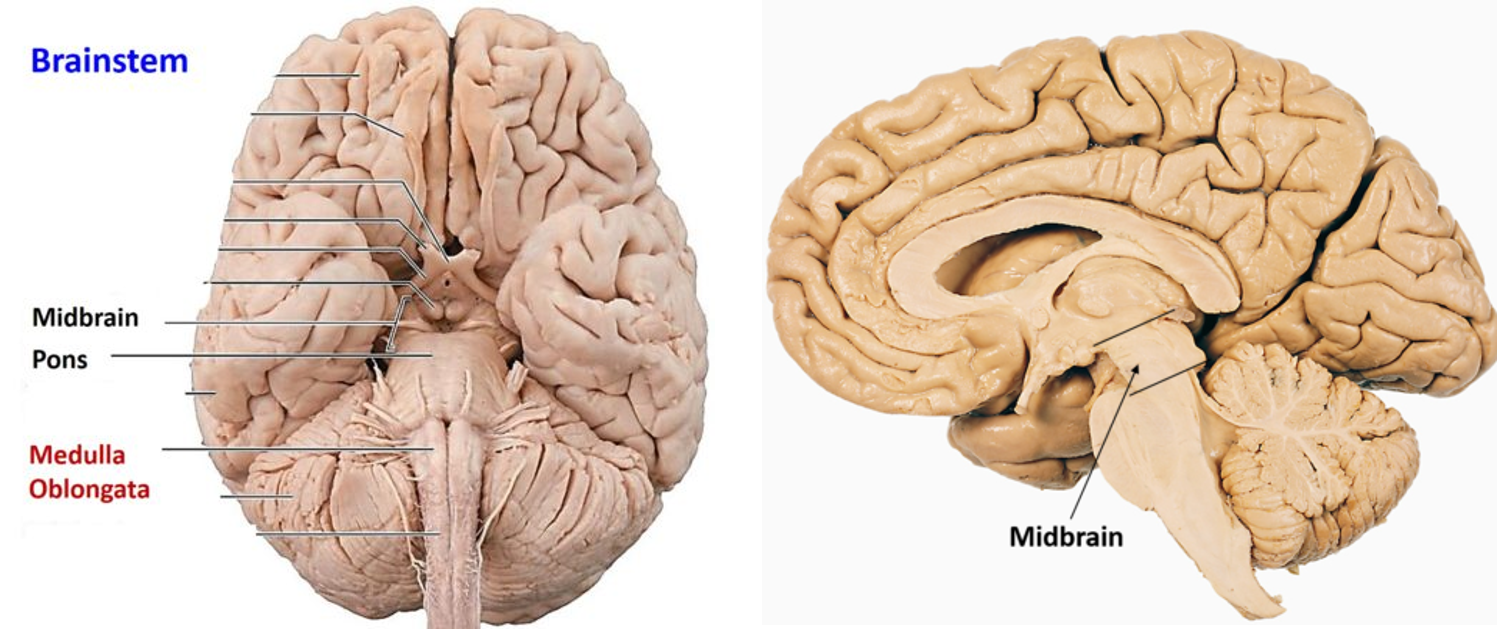Advertisements
Describe the external features of midbrain.
A. Midbrain
- is the uppermost part of brainstem.
- is continuous below with the pons and above with forebrain.
- has a cavity ( canal) called cerebral aqueduct, which connects third ventricle to fourth ventricle.
- has two surfaces- ventral and dorsal.

External Features of Ventral Aspect of Midbrain
- Two large bundles of fibers called cerebral peduncles are present of either side of midline.
- The space between the two cerebral peduncles is called interpeduncular fossa.
- The oculomotor nerves emerge on the medial aspect of peduncle.
External Features of Dorsal Aspect of Midbrain
- Four rounded swellings known as corpora quadrigemina are seen of the dorsal aspect of midbrain. Corpora quadrigemina comprises of a pair of superior and inferior colliculi.
- Superior colliculus is connected to to lateral geniculate body (part of metathalamus) via superior brachium.
- Inferior colliculus is connected to to medial geniculate body (part of metathalamus) via inferior brachium.
- Just below the inferior colliculi is the superior medullay velum ( white matter stretched between superior cerebellar peduncle).
- Trochlear nerve emerges from the superior medullary velum and then winds around the cerebral peduncles to reach the ventral aspect (trochlear nerve is the only cranial nerve that emerges on the dorsal aspect of brainstem).
Name the structural components forming internal structure of midbrain.
Midbrain is divided into two parts by an imaginary transverse line passing through the cerebral aqueduct:
- Cerebral peduncles: the part ventral to the imaginary line is formed by a pair of cerebral peduncles. The cerebral peduncles are further divided into three parts. From ventral to dorsal these are:
- Crus cerebri: consists of following longitudinal running fibers:
- Frontopontine – in the medial 1/6th of crus cerebri.
- Corticospinal and corticonuclear – in the middle 4/6th of crus cerebri.
- Temoporopontine, parietopontine and occipitopontine – in the lateral 1/6th of crus cerebri.
- Sustantia nigra: is a dark area (due to neuromelanin) that lies posterior to crus cerebri.. its neurons produce dopamine (dopamine is reduced in Parkinsonism patients).
- Tegmentum: lies between substantia nigra and tectum. It contains :
- Nuclei- red nucleus and pretectal nucleus.
- Ascending tracts – medial, trigeminal, lateral and lateral lemnisci.
- Descending tracts- Tectospinal, rubrospinal .
- Medial longitudinal fasciculus and reticular formation.
- Crus cerebri: consists of following longitudinal running fibers:
- Tectum: is the part that lies dorsal to the imaginary transverse line. It consists of of superior and inferior collicului.

Write the functions of important nuclei located in midbrain.
Following are the important nuclei located in the midbrain and their function.
- Superior colliculus: relay nucleus for visual reflexes.
- Inferior colliculus: relay nucleus for auditory reflexes.
- Red nucleus: controls muscle tone and posture (relay center for Cerebro-rubro –spinal & cerebello-rubro-spinal pathways).
- Pretectal nucleus: center for direct and consensual pupillary light reflex ( its lesion causes Argyll Robertson pupil – accomodation is possible but light reflex is lost)
- Substantia nigra: regulates motor functions, is associated with basal ganglia. Synthesizes dopamine (deficiency of dopamine results in PARKINSONISM).
Describe briefly the medial longitudinal fasciculus (MLF).
Medial longitudinal fasciculus:
- Runs in brainstem in the paramedian region.
- Fibers mainly arise from vestibular nuclei.
- Interconnects nuclei of IIIrd, IVth, VIth, VIIII CNs and spinal N of XIth.
- Function of medial longitudinal fasciculus : to coordinate the movement of eyes, head & neck in response to stimulation of VIIIth nerve

Name the arteries that supply midbrain.
The arteries that supply midbrain are:
- Posterior cerebral artery (branch of basilar artery).
- Superior cerebellar artery ( branch of basilar artery).
- Posterior communicating (branch of internal carotid artery).
Draw transverse sections of midbrain to show the internal features at the of inferior colliculus.

Draw transverse sections of midbrain to show the internal features at the of superior colliculus.

Applied Aspects
Weber Syndrome

Structure Involved Resultant Signs and Symptoms Coticospinal tract Contralateral hemiplegia Oculomotor nucleus Ipsilateral ptosis and lateral squint Edinger westphal nucleus Ipsilateral dilated pupil and lossof light reflex and accomodation reflex
Argyll Robertson pupil
- Are pupils that constrict when focusing on a near object (i.e., Accommodation reflex is present) but do not constrict when exposed to bright light (i.e.,Pupillary light reflex direct as well as indirect are absent).
- Occurs due to damage to fibers from the pretectal nuclei of midbrain to the Edinger Westphal nucleus. As the pathway for accommodation reflex does not include pretectal area, therefore, it is not affected. The pathways for ‘Pupillary light reflex’ and Accommodation reflex’ are shown in the diagram below:



